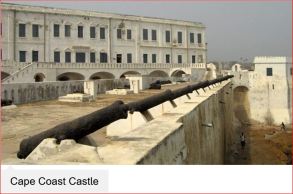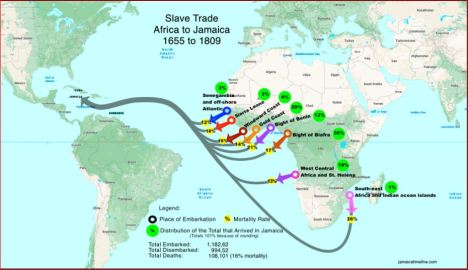.
Map: UK African slave routes to Jamaica, 1655-1809. Source: Slave Voyages Database-Trans-Atlantic Slave Trade-Estimates, via JamaicaGreatHouses.com…UK “merchants” needed 10,000 new African slaves every year for Jamaica sugar death camps. The labor was so hard that a third of each new shipment of slaves died within 3 years, creating a constant demand for new slaves. “Every slave was expected to work-even women, children and the elderly.” (BBC)
……………………………
“The triangular trade,” bbc.co.uk, “The slave trade brought vast wealth to British ports and merchants but conditions were horrific. Slaves were moved on the ‘Middle Passage’ of the triangular trade route. Many did not survive.”
 [Image: Cape Coast Castle slave factory seized by UK in 1662, captured slaves were held in dungeons, BBC]
[Image: Cape Coast Castle slave factory seized by UK in 1662, captured slaves were held in dungeons, BBC]In 1672 the British Royal African Company established a base at Bance Island in the Sierra Leone River. Bance Island became a major centre for the transatlantic slave trade. It remained in use for nearly 140 years.
Life in the slave factories…


No comments:
Post a Comment